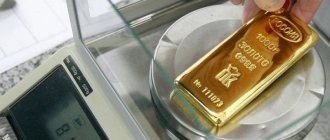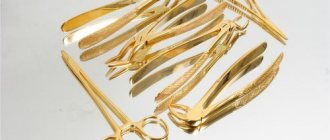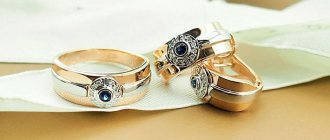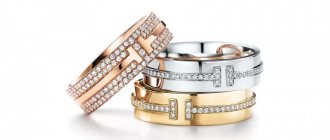In a number of previous articles on the topic of gold investing, for example, “ How to invest money in gold, ” you received a general idea of gold, in this material we will talk specifically about gold bars.
One of the tools of modern investment are gold bars. Fundamentally, the main purpose of investing in gold is to preserve your savings for many years. Due to its reliability and stability in the market, buying gold bars for a modern person can be a good way to invest in currency or stocks. To visually represent the essence of the concept of gold bars, we will give examples of their varieties.
Measured gold bars
Measured gold bars are bars that are produced by Russian or international refineries in accordance with all standards. The amount of pure gold in them is 99.9%. The weight does not exceed 1000 grams, and the sizes can be completely different. They make up the bulk of the bars on the market that are the most popular among buyers.
For measured gold bars, GOST R – 51572-2000 is provided. Each of them is necessarily confirmed by a corresponding certificate with all the main characteristics.
Peculiarities:
- There are two types of ingots - cast and stamped. Cast: from 100 grams to 1000 grams; stamped: from 1 gram to 50 grams.
- Upon agreement with the manufacturer, it is possible to order ingots of any size and shape; thickness is not standardized.
- Each copy must be clearly marked on the front side (convex or depressed). The marking can be not only on the front side, but also on the back.
- Each ingot has its own unique number.
- The notation is very simple. For example: SSHZ 20 stands for - an ingot of stamped gold weighing 20 grams; or SLZ 100 – an ingot of cast gold weighing 100 grams.
Although according to standards there are specimens weighing 1 gram, it is impossible to find them in jars, unless you order directly from the manufacturer.
The essence of the concept of “gold bar”, types
In the banking industry they use the concept of a gold bar
. The term denotes a precious metal of a particular size, shape and quality. Gold purity for bars is 0.995 and higher.
Depending on the production method, the following types of bank bullion are distinguished:
- cast: the molten mass is poured into molds and kept in them until completely solidified, after which they are minted;
- stamped: a stamp is pressed onto hot workpieces;
- powder: the mass is formed by electrolysis.
Stamped products are usually more expensive than cast ones. Powder ones are practically never found in domestic institutions.
Standard gold bars
Standard ingots are manufactured at the same refineries as standard ingots, but in this case they are manufactured and marked exclusively according to state standards. It is in such bars that Russia's gold reserves are stored.
Corresponding GOST 28058-89
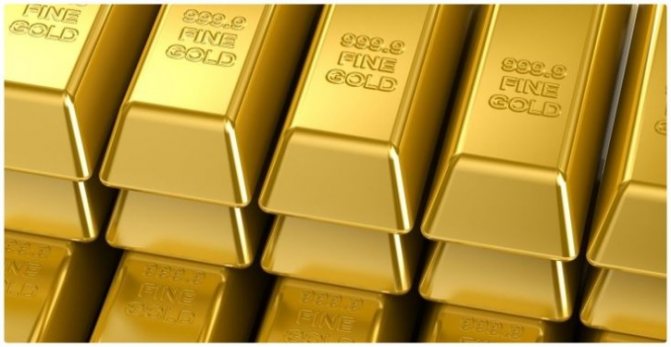
Peculiarities:
- The weight of standard bars ranges from 11,000 to 13,300 grams.
- Gold purity not less than 99.95%
- The shape of a standard ingot can be exclusively a rectangular truncated pyramid.
- The surface must be free of marks, any physical damage or stains.
- There may be a concavity on the front side due to metal shrinkage, but not more than 5 millimeters.
- Each copy must be marked in accordance with the standards and have a certificate, as in the case of ingots.
Buy a gold bar: selection factors
To buy a gold bar
to achieve maximum benefit, the following factors must be taken into account:
- Purpose of purchase: investment, storage, deposit, for melting;
- price differences in financial institutions;
- gold content;
- discrepancy between the cost of purchase and sale in branches;
- availability of bars of the required size in the bank;
- refining company: domestic, foreign;
- packaging: facilitates storage and transportation.
Cheaper cast gold is purchased for remelting.
Before purchasing, information is clarified at a specific bank, over the phone or in person.
Gold bar: buyout price
You can purchase a gold bar at banking institutions and at the precious metals exchange . Price
resale depends on the following circumstances:
- ingot weight;
- try;
- refining company;
- safety of packaging: some institutions accept products only in a branded case;
- damage to the product: if there are flaws, the bank can accept the ingot at the price of scrap;
- availability of documentation: certificate, receipt.
To operate with gold, the bank needs a special license from the Central Bank.
Bank margin allows gold to be used as a speculative material.
Ingots
With sharp fluctuations in the ruble and foreign currencies, gold bars become a reliable investment for many Russians. However, there are difficulties - you have to pay a fairly large tax for storing precious metals.
According to manufacturing technology, ingots can be cast, stamped, or powdered. Measured ingots are used for storing gold by the population, standard ingots are used for melting into other products.
Measured gold bars are bars weighing up to 1 kilogram and having a purity of 999.9. They are marked with weight and manufacturer. Such ingots are manufactured according to the Russian standard - GOST R 51572-2000.
Requirements for ingots:
- For each denomination of ingots, deviations in the following parameters are allowed: length, width and thickness.
- It is possible to change the shape and size of the bars, which is specified in the transaction agreement.
- The presence of dirt, grease stains, and scratches on the metal surface is unacceptable.
- Due to the softness of gold, bars can become deformed over time and take on a different shape - curved, concave. The surface may become wavy.
- The marking can be either curved or convex, but legibility in indicating the mass of the ingot is required. Correction of the inscription is unacceptable.
- The presence of a distinctive sign on one or more sides of the product is permitted.
Mandatory markings on domestic ingots:
- “Russia”, circled in an oval;
- mass in numbers;
- the name of the metal is “Gold”;
- sample or share;
- manufacturer's mark.
The registration number of the ingot is indicated below.
Many banks offer measured gold bars. Sberbank is the leader in Russia in the exchange of funds for precious metals and its storage. Other banks also sell gold and offer storage services.

Gold bars of different denominations
Yellow currency is stored both in the form of coins and in the form of bars of different weights. How much does a gold bar weigh? There are several denominations: 1, 5, 10, 20, 50, 100, 250, 500, 1000 grams. The metal purity in measured ingots is standardized and amounts to 999.9, which corresponds to the Russian state standard. The production of ingots and their marking are carried out by refineries.
Sberbank branches sell bullion at the following prices:
- A whole gold bar weighing 1 gram costs about 1850 rubles if the bank buys the gold. Banks sell a similar resource at much higher prices - 2700-2900 rubles per 1-gram denomination. This price includes value added tax.
- 5 gram denomination cans sell for 12,400-12,700 rubles. Banks can accept the same gold bar from the population, depending on its technical condition, for a cost of 9200-9400 rubles.
- A ten-gram standard bar of yellow metal will cost the buyer approximately 24,000 rubles, while it can be sold to a jar for 18,000 rubles.
- A denomination of 20 grams is valued by banks at about 49,000 rubles. The sale of the same measured ingot will bring its owner about 36,000.
- A 50-gram gold bar will cost the buyer approximately 121,000 rubles. A bank can accept 50 grams of refined gold from a private person in exchange for about 92,000 rubles.
- Banks sell a 100-gram gold bar for 242 thousand Russian rubles. A private person can sell the same gold bar for a price of about 184,000 Russian rubles.
- A quarter kilogram of a refined gold bar will cost the buyer 603,000. Among the population, banks accept bars weighing 250 grams for approximately 460,000 rubles.
- The price of a half-kilogram ingot is about 1,205,000 rubles. A private individual can sell his 500-gram stock for 921,000 rubles.
- A gold bar weighing one kilogram costs 2,408,700 rubles in Sberbank branches. They accept similar bars for sale at a cost of 1,843,000 rubles. Value added tax of 18% is also taken into account.
Some bars are produced in special packaging that protects them from dirt and grease, as well as damage.
Bank gold in measured gold bars is also produced in 585 standard, the content of the main metal in which is 58.5%. The remaining share comes from the alloy - other metals that give strength to the ingots.
Sberbank gold bar: types of transactions
The best investment decision is to purchase a gold bar. Sberbank
offers clients the following services:
- sale of stamped and cast products weighing from 1 to 1000 g;
- purchase of bank bullion;
- storage of precious metals: bank vault or special individual safe.
The ingots have a purity of 999.9, a stamp, and a quality certificate. Each product is supplied in individual high quality packaging.
The maximum deviation of the ingot mass from the norm according to GOST ranges from 0.03 g for a one-gram product to 0.10 g for a kilogram.
Gold bar: weight, other parameters
State standards prescribe the following parameters that a measured gold bar has:
- weight from 1 to 1000 g;
- linear parameters length/width;
- noble metal content in the alloy – 99.99%;
- absence of foreign inclusions, abrasions, grease stains and other defects;
- presence of markings on the front side: weight, sample, trademark of the refining company, number.
Standard ingots weigh between 11 and 13.3 kg.
The dimensional parameters of the ingots are specified in GOST. At the customer's request, manufacturing plants cast ingots in parameters different from the standard ones. A certificate is issued for each copy.
Gold bars. Description and application of gold bars

It was a metal accessible to them, since merchants set a high price for tin. And in the Torunda River, along the banks of which the taiga people grazed their herds, one could always find free nuggets. The Tungus collected gold and cast soft bullets from it. And today this metal is sometimes used in extraordinary ways - it is used to make clothes, toys for children, even toilets in rich houses. But the more familiar form of gold for us is in the form of bars. Banking organizations sell them as investment goods. How are gold bars made, what types are there?
Production of gold bars
Each ingot is poured from a charge - this is a special material from which a briquette is smelted. They use pure metal, jewelry scrap, and defective gold items, including bank blocks. After preliminary cleaning of the charge, 100% gold remains. It is this that is used for melting in induction furnaces, in which a graphite crucible (heating container) is installed.
According to the federal standard, banks can sell 999.9 gold bars. To clean the alloy from impurities and contaminants, even the smallest ones, flux is placed at the bottom of the crucible. This substance is also sprinkled on top of the mixture. This additive “takes away” all contaminants from the alloy, turning them into slag. The metallurgists' task is to separate the resulting slag from the gold.
While the heated gold mixture is settling, the flux takes away the existing impurities. Initially, the alloy is heated to 1.3 thousand degrees Celsius. Then the cooled mass is cleaned and poured into a cast iron mold (mold) to form an ingot.
The mold is preheated to a temperature of more than 600 degrees, then the metal is poured. Heat the mold so that the hot metal is evenly distributed throughout the niche. If there is a cavity left on the ingot, it will be defective. It is unlikely that there will be anyone willing to buy gold bars with a defect.
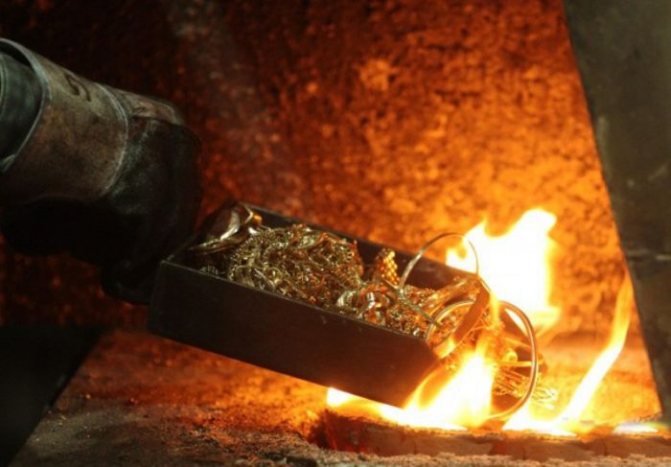
Many housewives will compare the process of producing ingots to baking shortcrust pastry. Molds for ingots are sprinkled with graphite coating, then hot gold mass is poured through a chute and sent to the oven for baking. After some time, the mold is removed from the furnace, left to cool, and then the finished ingot is removed.
It will take a few seconds for gold to crystallize. The jelly-like mass of valuable metal becomes a familiar ingot for us. The block is removed from the mold with tongs and immediately lowered into water. While the product is cooling, a melt sample is sent to the laboratory.
This is how gold bars from Sberbank and other banking institutions are cast. Their prices depend on certain characteristics of the alloy. If the product meets the established parameters, a quality mark and mark are placed on the gold briquettes.
Types of gold bars
As a rule, Sberbank sells gold bars made in two types. The maximum weight of such a block is 1 kg. The smallest measuring ingot starts at 1 g. Federal law requires that any ingot must have a purity of 999.9. The appearance of such products corresponds to one of two GOSTs: 51572, 51784. The first standard document appeared in 2000, a year later the second edition appeared.
If gold bars are sold, each block must contain the following information: the weight of the product, its fineness, the state of manufacture, the name of the element, the emblem of the plant where the bar was cast, and also the serial number of the product.
When is it not possible to buy gold bars? An ingot with a greasy coating on the surface, in the presence of burrs, cracks and delamination is considered to be of poor quality. Shrinkage and concavity of the ingot is also a defect - this is the result of their long-term storage. Such briquettes are recyclable.
Ingots can have different thicknesses and this is allowed. The width of such a product is not standardized by GOST. An important indicator of an ingot is its mass. The bullion must be weighed on electronic scales before purchase. When all verification procedures are completed, you can purchase a gold bar from Sberbank or another banking organization.
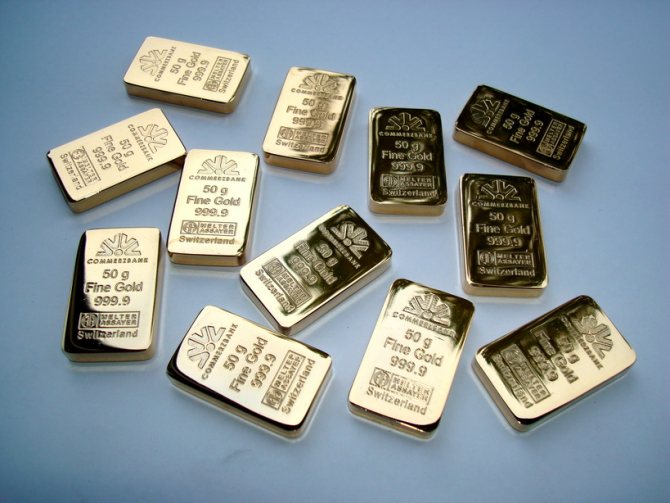
GOST 1989 is used in the production of standard gold bars. To determine the quality of a block, the standards of document 28058 are used. A measured ingot is called lightweight, a standard ingot is called heavyweight. The minimum weight of such ingots starts from 11 kg.
The maximum weight of the ingot reaches 13.3 kg. There are no product regulations regarding the size or shape of the casting. The parameters of the bars are set by the bank, being the customer, but most often they are cast in the shape of truncated pyramids.
Regulations for standard blocks allow stripping no deeper than 1 mm. The following information is indicated on such a block: year of manufacture, manufacturer, sample, weight of the ingot, state emblem, type of raw material, serial number.
20.10.2016 10:59
